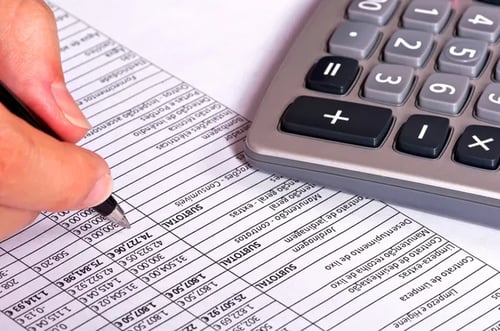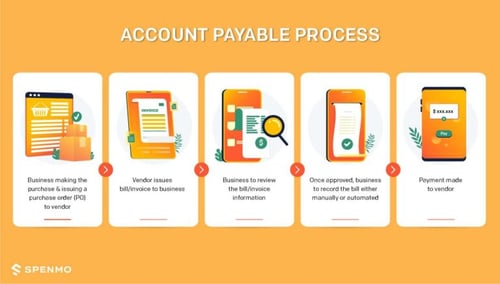A Business Owner’s Guide to Supplier Invoice Management
A Supplier Management System has tons of benefits for your businesses. Read on if you are interested to know how to automate your invoice process.
Broaden your understanding of the accounts payable process to allow your company to track and settle payments. This streamlines the procurement process.
You have to settle these debts to avoid default. Your accounts payable is an essential part of your company’s general ledger. If it increases over a short period, it only means that your small business is buying more products and services on credit instead of acquiring them through cash.
If it decreases, then it means that your company is settling its debts at a rapid speed rather than acquiring new products and services on credit. Efficiently managing accounts payable is crucial in managing your small business’s revenue.

Image Source: static7.depositphotos.com
Your accounts payable is responsible for paying suppliers or lenders for the products and services that your small business purchased from them. Usually, they deal with financial statements, but they can also do other functions depending on your company’s nature and size.
Your payable department may have to deal with vendor payments, internal payments, business travel expenses, and other functions.
Huge companies that ask their bottom line to travel may assign their AP department to handle the travel expenses. Your small business’s travel expenses may include reservations, car rentals, or booking plane tickets. Depending on your company’s set policies, your team members can distribute and ask for funds to cover travel expenses.
Then, the AP team will be responsible for settling funds distributed and funds spent. It may also include settling travel reimbursement requests.
Your AP is responsible for facilitating the distribution of sales tax exemption certificates and distributing internal reimbursement payments. Make sure to ask your employees for receipts, log reports, or both for reimbursement requests.
Other minor expenses, such as company meeting dinners, out-of-pocket office supplies, or miscellaneous postage, are called petty cash. Your payable department will also facilitate distributing a sales tax exemption certificate to ensure business transactions don’t include sales tax expenses.
Your AP handles payment terms, and vendor contact information through accounting software or manual reports. In addition, they’ll verify business transactions or handle pre-approved orders after purchasing a product or service. Lastly, they can also deal with end-of-month analysis reports that allow the management to discuss their current debts.
Your AP department also reduces costs by developing ERP strategies and paying attention to details to save your business money. Besides, they can also work as the direct contact between a vendor representative and your small business. Your strong business relationship with suppliers or lenders can help their representatives provide you with a more eased credit term.

Implementing a set of strategies for your invoice processing before paying a supplier or lender is also advisable. Having a set accounts payable process is necessary due to the volume or value of your company’s transactions. It may include:
If your small business purchased products or services, asking for a bill helps keep track of the quantity of what was purchased. In this phase, you’ll also learn about the financial statements’ validity.
Make sure that your bills state the date, authorization, and vendor name. Your purchase order should also contain the matching and verified requirements.
Make sure to update your records after receiving them. You’ll also have to keep track of the expense entry. You might also need managerial approval at this phase, with the approval hierarchy stamped on the financial statements.
You should settle payments before or on their due dates, as agreed upon between your company and a supplier. You should also prepare and verify the needed documents. In addition, make sure to triple-check the details stated on the purchase order, original bill, payment vouchers, vendor bank account details, and cheque.
You might also need to get invoice approval at this phase. Your AP team has to oversee the following full-cycle accounts payable automation process to ensure that you’re protecting your assets and money:
Managing your accounts payable is one of the essential automation solutions that can help you efficiently settle debts or payments. You may have assigned your back-office to do your small business’s accounting process automation, but bear in mind that it’s a necessary process.
Your payable department’s productivity and workflow depend on how efficiently they can handle the procure-to-pay cycle. With that, it helps them settle payments on time to avoid late fees, penalties, and overdue charges. Building a strong relationship with your suppliers or lenders will also benefit your company in the long run.
If your small business makes timely payments, a supplier or lender will be motivated to provide you with their products and services continuously. Your company will become more efficient and organized with that. You may also enjoy a few discounts from a vendor.
Your AP should also make sure that they track and settle payments before due dates. It helps minimize duplicate payments for the same bill or missing payments. On top of that, it helps your small business maintain a good cash flow. Having an efficient AP process will also help you minimize the risk of fraud and theft in the company.
 Image Source: media.istockphoto.com
Image Source: media.istockphoto.com
Your company’s accounts payable can significantly affect your cash flow. Making your payable cycle more accessible will help you maintain good vendor relationships with your suppliers or lenders, working to your advantage.
If you haven’t organized your accounts payable process, you need this guide to learn about the challenges you might encounter and how to address them. If it comes to this aspect of your business, there’s always room for improvement.
Manually managing your accounts payable can be overwhelming. If your internal controls are inefficient, the outcome can be frustrating. For example, getting approvals will take more time if you send invoices around by mail or hand. You may have already incurred a late payment penalty or missed a discount when you settled the debt.
On top of late payments, you can also face unauthorized purchases if your bookkeeping process is inefficient. Not setting rules about who should authorize the orders, how much your company should spend, and what products and services to purchase can significantly affect your finances and budget.
Manual processing of paper invoices makes things more complicated. Your company’s purchase transactions and the number of audit trail paperwork you’ll have to handle will also grow if your business expands. Now, you’ll be facing two problems: difficulties in tracking the documents and storage costs.
Even if you have a highly efficient AP process of tracking the records, you’ll soon realize that updating, retrieving, and storing invoices is exhausting and tedious. Keeping the papers can also be dangerous because they might get destroyed, or you might lose them.
Your AP department may also have to get managerial approvals, provide the invoice’s details, and settle the payment. If you’re using manual invoice data entry in each aspect, there’s a higher risk of errors, resulting in incorrect payments or calculations. Making a mistake will have a negative consequence on your company’s financial resources.
To determine and address errors, you’ll have to check your ledger accounts manually until you find them. That can be time-consuming, which you could have spent on a more critical aspect of your business.
Manual practices can result in lengthy approval periods while passing the documents to the respective departments. Ultimately, it leads to late payments, especially if you’re still sending invoices through mail. It’ll also take you a long time to approve payments.
Missing the due dates can lead to different problems, including delayed goods shipments and late payment fees. It can also negatively affect your business’s credit ratings, further lowering your chances of obtaining favourable terms from your vendors.
Duplicate payments can happen for various reasons. Many of which are associated with manual invoice data entry. Inconsistencies in manually recorded invoice amounts and supplier or lender information can cause double or multiple payments. You may also accidentally make double payments if you use multiple systems instead of an integrated one. You’ll need automation to grow your business.
Some Examples of Accounts Payable Expenses |
||
| Leasing | Take a mobile network company as an example. Most of them will need telecommunications equipment, and they can obtain these through a credit period of six months. In most cases, telecommunications equipment is complex, so network providers hire a vendor to build that infrastructure. | |
| Products and Equipment | Let’s continue with the previous example. If you rent the equipment, the payments pending to the supplier will fall under your accounts payable. Leases are called a fill-in due to the overall costs of the capital expenditure involved. | |
| Transportation and Logistics | You’ll have to transport the raw materials from a supplier’s warehouse to your manufacturing plant. In addition, you’ll have to talk your manufactured goods to a warehouse or the buyer’s mailing address. You’ll find different modes of transportation. In other cases, you might need more than one mode of transportation. Instead of owning a fleet and paying a bottom line, it’s easier to hire a third-party provider. | |
| Services | Even if your company has its manufacturing unit, you might still need to subcontract to another company. That’s because the other company may be an expert, or you lack the certifications or licenses required for that kind of work. | |
| Power and Energy | Your manufacturing company may need fuel, power, and raw materials to complete the production process. But you can’t purchase these items through cash. Hence, you buy them on credit with a grace period of 30 days. Until you pay your supplier of fuel, power, and raw materials, they’ll fall under the accounts payable. | |
Having trouble managing your accounts payable system? Get professional assistance from Spenmo today.
Did you know that the accounts payable process also involves reviewing an enormous amount of detail to ensure that only legitimate and accurate amounts are entered in the accounting system?
You should implement the proper methods to streamline your accounts payable. Doing that will help you address problems that prevent your department from being efficient. You can automate the payable cycle and store the AP documents on an integrated system.
You’ll get an end-to-end AP automation process that centralizes, stores, evaluates, measures, integrates, and captures essential information. You can also reduce manual data entry and paper-based practices. You’ll have to ask your vendors to submit digital bills.
Using leverage invoice capture software will help you quickly extract the necessary information. You can also use payment reminders to ensure that you get reminded of due dates. It’ll help you avoid missed or late payments and benefit from early payment discounts.
Keep a report of your monthly transactions. Keep track of your payment history, voucher activity, and monthly reconciliation reports to help you understand your company’s cash flow. You can also prepare for information requests and audits.
Keeping track of all your accounts payable is a challenging task. Make a human error, and it’ll affect the entire payable cycle. Manual updates can also lead to many problems, making the task more exhausting than it already is.
One solution we can think of is hiring the right people. Spenmo always has the right tools for making the bookkeeping process more accessible. With our team, you can streamline everything, from making purchase orders to settling your invoices.
Your company doesn’t have to worry about missing any payments. Feel free to visit our site to schedule your first demo.
Your accounts payable are unsettled debts or payments, while expenses are invoices or bills that you've already settled to generate revenue.
PO invoices include the details of the products and services that your supplier has provided as agreed upon. It can also include the purchase order. If you've filed for a purchase requisition, that transaction will generate a pre-approved purchase order (PO) that you'll have to send to your supplier.
Non-PO invoices don't have a purchase order and result from the expenditures outside the company's regulated procurement process. Your AP team uses this invoice for additional indirect purchases.
Your payable department is responsible for paying suppliers or lenders for the products and services that your company purchased from them. Usually, they may have to pay invoices, but they can also do other functions depending on your company's nature and size.
Your team members may have to deal with vendor payments, internal payments, business travel expenses, and other functions.
A Supplier Management System has tons of benefits for your businesses. Read on if you are interested to know how to automate your invoice process.
The procure-to-pay process is long and complex when done manually. Discover how you can automate your company procure to pay cycle with Spenmo.
Reconciling business finances is a must for successful operations. Learn the steps for an efficient vendor reconciliation process in accounts payable.
Sign up to get the latest news, updates, and special offers delivered directly to your mailbox